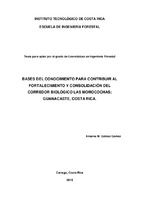Bases para el conocimiento para contribuir al fortalecimiento y consolidación del corredor biológico Las Morochas; Guanacaste, Costa Rica
Abstract
Fragmentation and degradation have led to changes in natural
environments, which have brought the loss of biodiversity and sustainability of
our natural resources. Therefore, alarming reactions have taken place globally;
due to the speediness by which these changes are taking place; so, some
conservation strategies have been developed and implemented to revert the loss
of biodiversity. One of strategy to mitigate the negative effects is the design of
biological corridors, which serve as means of connectivity between fragmented
forest ecosystems to help the flow of flora and fauna among isolated
populations. This study collected secondary information to characterize the
natural capital of the Biological Corridor Las Morocochas. The information
collected was: geomorphology, soils, topography, hydrology, land use capacity,
life zones, climate, flora and fauna. Besides, it was carried out a supervised
classification of land use with ASTER-14 images. With this analysis it was
obtained that 78% of the corridor have a mosaic of agricultural uses and 37.15 %
of fragmented forest. A connectivity diagnosis was done to assess the degree of
fragmentation and to identify the causes that disrupt forest
connectivity. According to the results of the calculated metrics; the fragmentation
index for this corridor is of 0.07 which indicated that it is highly fragmented and
that pasture land is the may cause that alters forest connectivity. Finally, an
exploratory survey was conducted to study the social and productive aspects of
associate with communities bordering the. It was concluded that the main
productive activities in the area are: extensive grazing, subsistence agriculture
and tourism. It was also found that 15% of the study area received the benefits
from the Program for Environmental Services (PES)
Description
Proyecto de Graduación (Licenciatura en Ingeniería Forestal). Instituto Tecnológico de Costa Rica, Escuela de Ingeniería Forestal, 2010.


